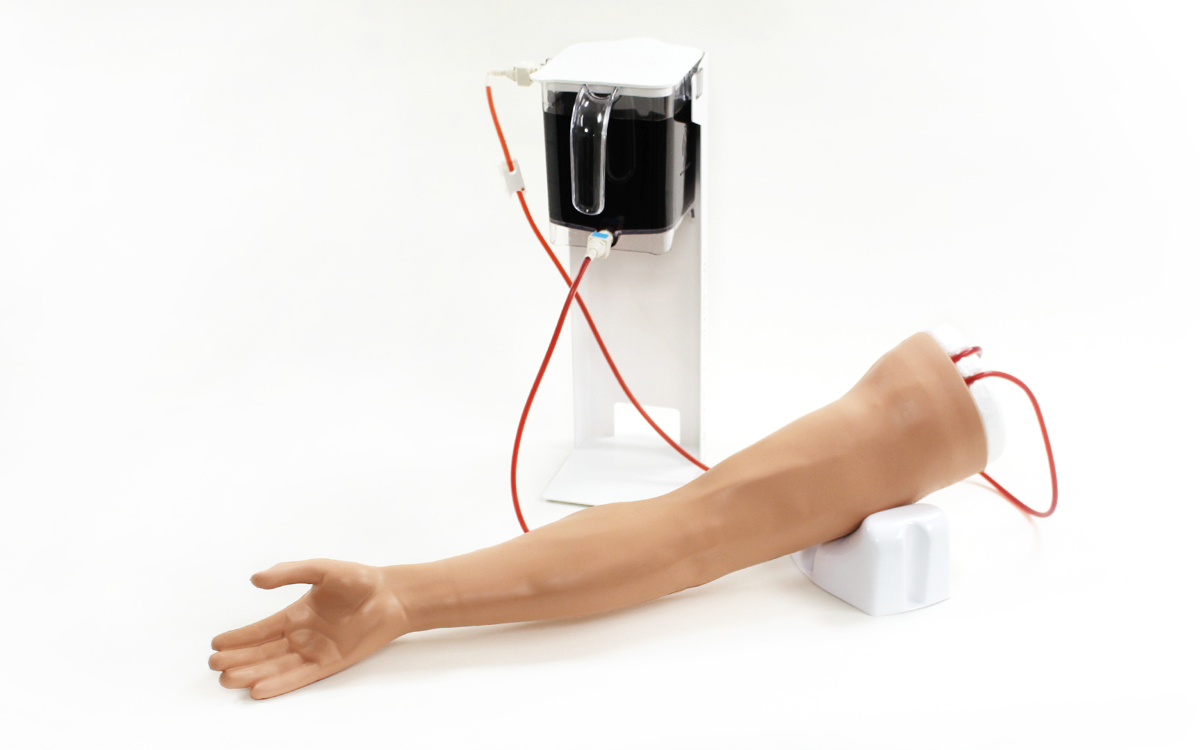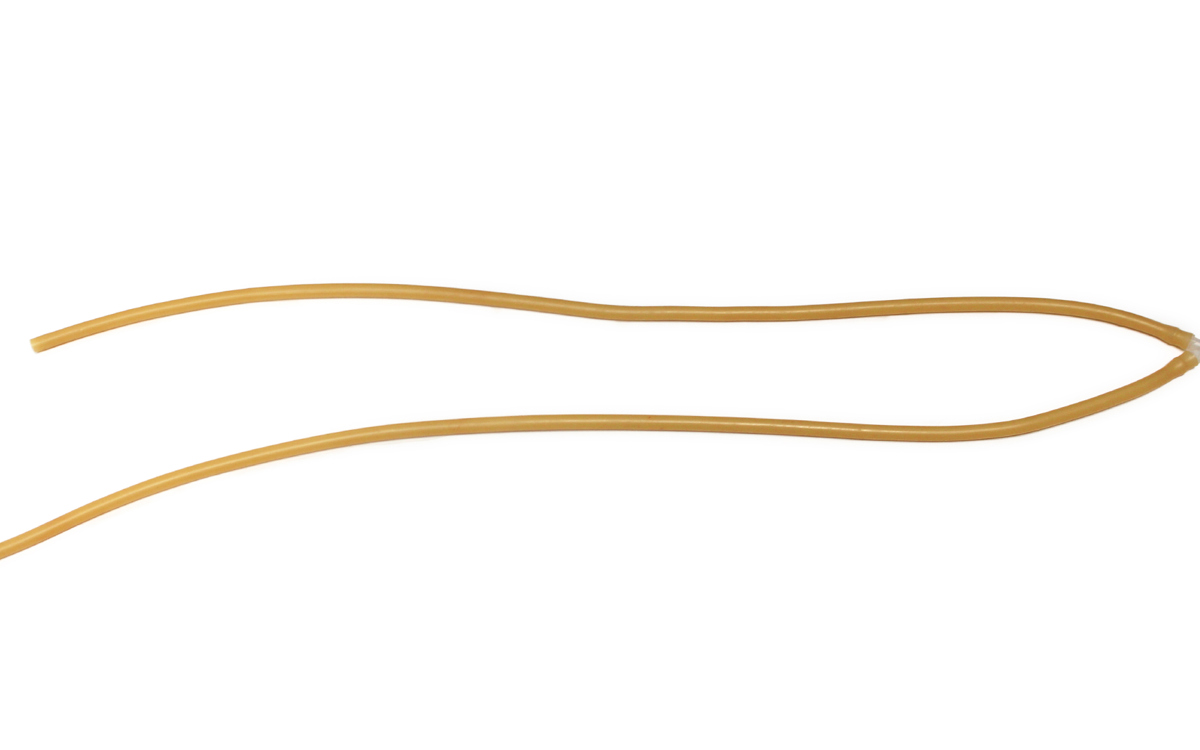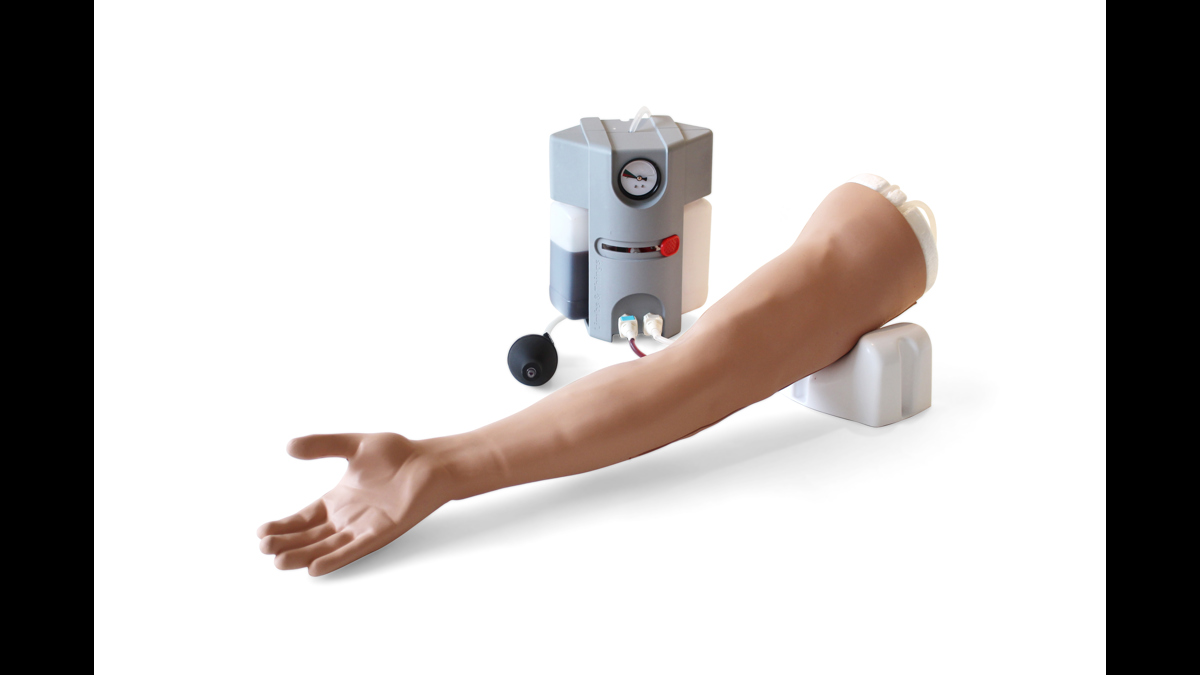










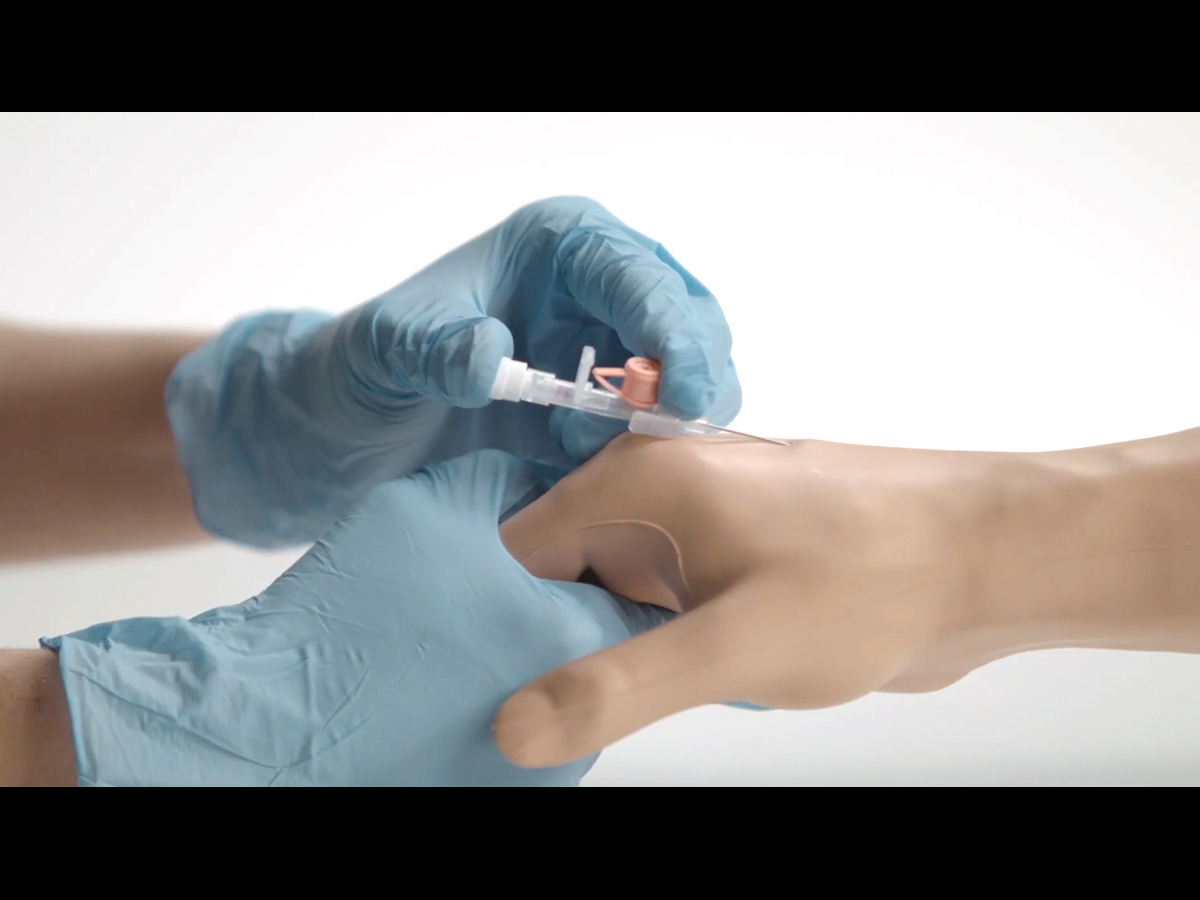

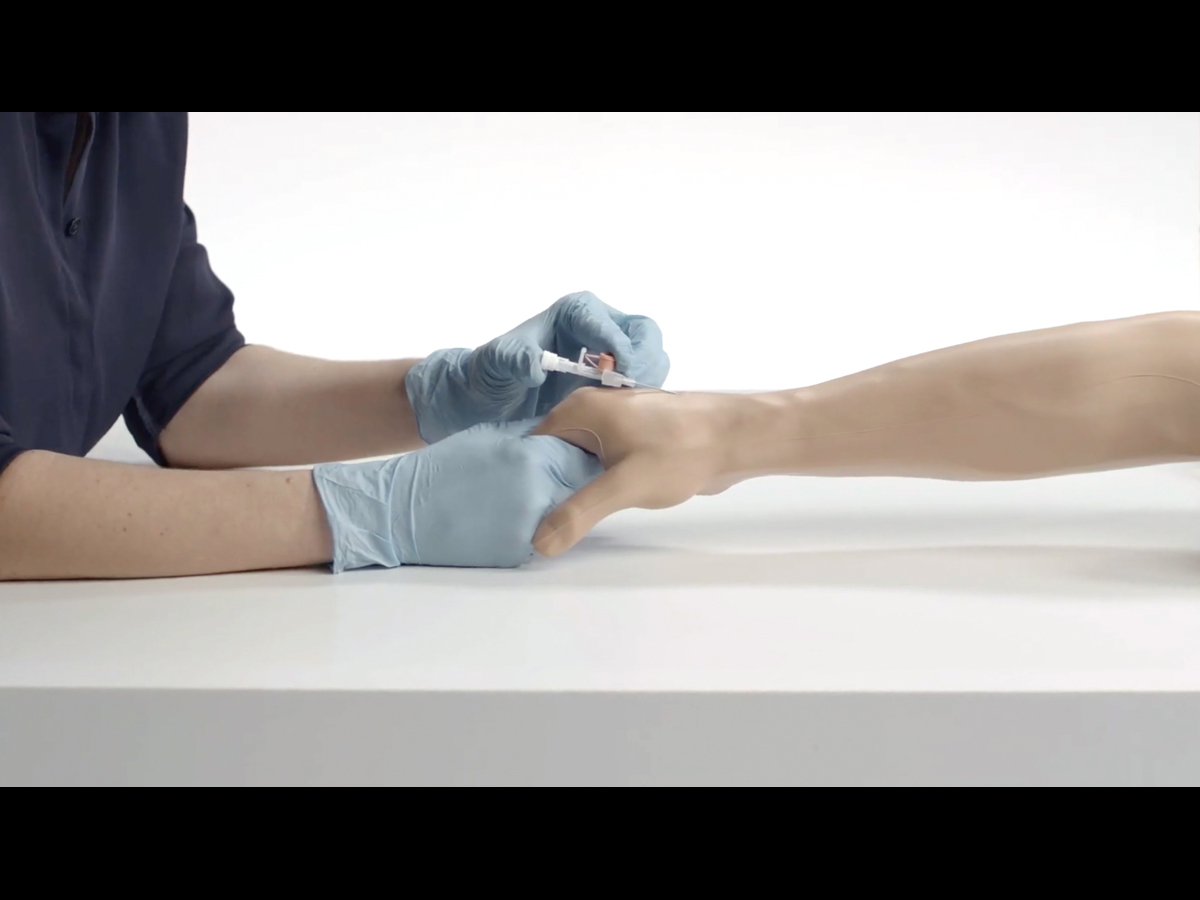






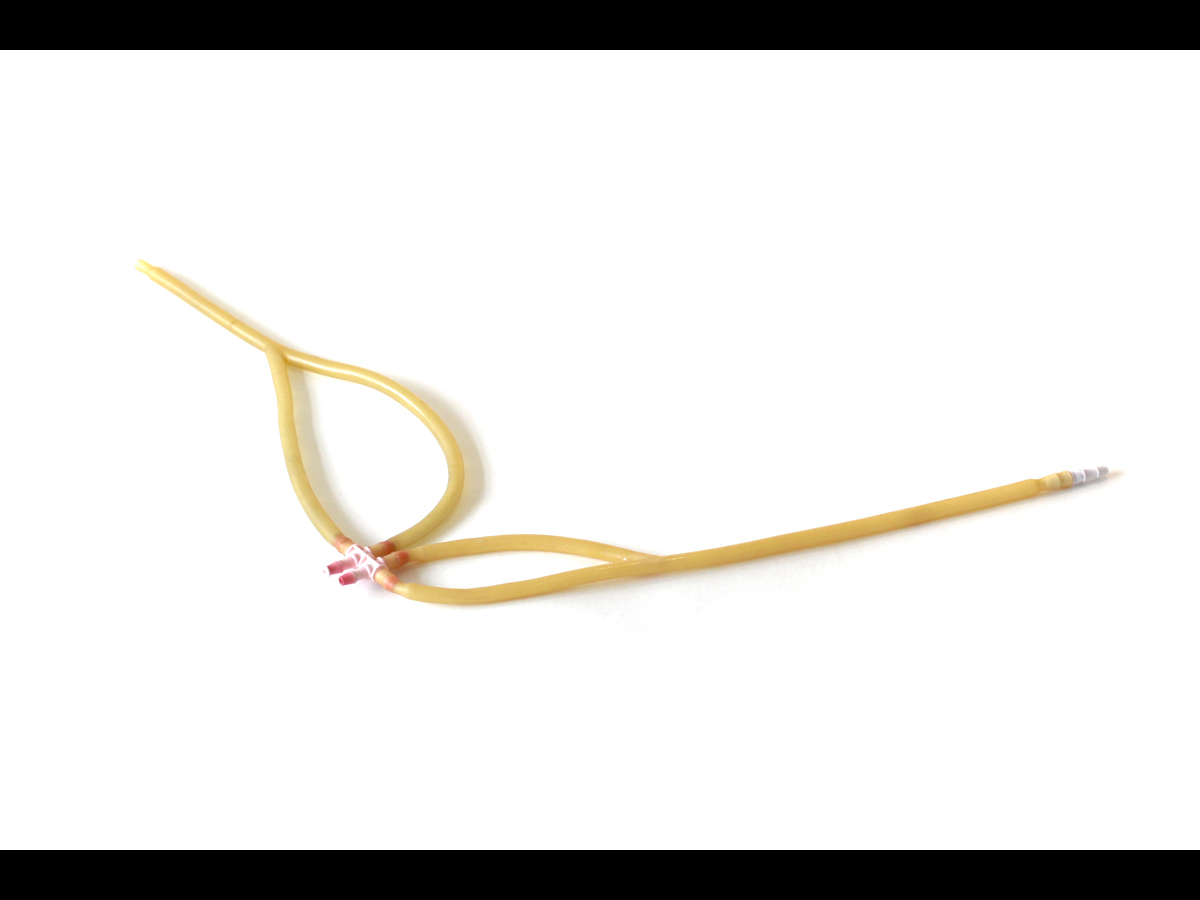
Advanced Venipuncture Arm (Light Skin Tone)
Skin Tone
Model
Adding to cart...
Added to cart
Sorry, something went wrong adding the product to the cart.
Realism in venipuncture, IV cannulation and IV infusion training
Building on the original venipuncture trainer range’s success, the latest models are now equipped with more life-like qualities to enhance the user experience.
- Modular veins offer close-to-life haptics with realistic blood flashback upon needle insertion, as well as being palpable to add digital pressure to stem blood flow
- Updated skin shows more definition and an improved matt skin color, with a soft texture for market leading haptic qualities
- The pressurized mock blood system gives a realistic blood pressure for trainees, with blood flashback when entering the vein
Designed for efficiency
Realism in venipuncture, IV cannulation and IV infusion training
Building on the original venipuncture trainer range’s success, the latest models are now equipped with more life-like qualities to enhance the user experience.
- Modular veins offer close-to-life haptics with realistic blood flashback upon needle insertion, as well as being palpable to add digital pressure to stem blood flow
- Updated skin shows more definition and an improved matt skin color, with a soft texture for market leading haptic qualities
- The pressurized mock blood system gives a realistic blood pressure for trainees, with blood flashback when entering the vein
Designed for efficiency
With its patented skin locking mechanism, modular metacarpal and ACF vein modules, and underlying vein gripping system, the updated Venipuncture Arm range allows for realistic, repeatable training.
Each venipuncture arm is delivered with veins and arm skin fitted. Simply prime with diluted concentrate blood and the venipuncture trainer is ready to use in minutes.
- Designed for efficiency: modular veins (including the median cubital vein), vein gripping feature and patented skin locking mechanism for improved re-veining and re-skinning
- Pressurised blood system allows arm trainer to operate at life-like blood pressure
Overview
- Repearable, realistic training
- Anatomically accurate vein placement
- Patented skin locking system improves time to re-skin arm and replace veins
- Vein gripping system allows for easy re-fitting and positioning of veins
- Realistic haptics for accurate clinical use
- Infusion tube allows for intravenous fluids to be administered
- Includes pressurised blood system
Realism
- Training arms privide realistic blood feedback
- Stem blood flow with digital pressure
- Life-like vein haptics and soft flexible skin
- Extended tubing available to connect arm to blood system for improved realism during training
- Veins in the metacarpal & ACF modules are palpable
- Realistic representation of the antecubital fossa (SCF) and metacarpal regions
- With the Advanced Pump, the advanced venipuncture arm operates at an accurate blood pressure
- Gripping systems secures veins in a true-to-life position
Versatility
- Supports use of vacuum blood collection systems, needles, syringes, and IV cannulas
- Supplied with Blood Concentrate starter pack. Formula is suitable for extended use. Refills are available
- Resetting the arm with new veins and/or new skin is easier than ever. Watch our instructional video on how to set up the Advanced Venipuncture arm on the Limbs & Things YouTube channel
Cleaning
- Flush liquid from the vein and fluid system before storing your product
- Clean the skin surface with a damp soft cloth, using warm water and mild detergent
- Allow to thoroughly dry before storing
Safety
- Only use Concentrated Venous Blood supplied with the arms, or product numbers 00020 & 00021, other fluids may weaken or damage the venipuncture simulator
- Use water-based lubricant to fit arm skin over the venipuncture arm base
- Veins contain latex, however, these are covered by the silicone arm skin during procedures
- The blood used within this product contains a preservative approved for use by EU cosmetic regulations. Once diluted, it is safe for extended skin contact. We would still recommend the use of glove and protective outerwear, as the pigment may stain skin and clothes
Simulated Patient
- Suitable for use with a simulated patient to test communication skills
Anatomy
Adult male right arm, below shoulder.
Sites for peripheral venous cannulation:
- Dorsal metacarpal vein in the hand
- Antecubital Fossa (ACF) vein in the arm
Metacarpal Vein Module anatomy:
- Basilic vein
- Cephalic vein
- Dorsal metacarpal veins
ACF Vein Module anatomy:
- Basilic vein
- Cephalic vein
- Median cubital vein
Skills Gained
• Practice of aseptic technique
• Venipuncture techniques for blood sampling
• Intravenous infusion/injections
• Intravenous cannulation
• Peripheral venous cannulation
• Locating veins through palpation
• Drawing blood via vacuatte system
• Placing a butterfly needle
• Scenario based skills: Professional to patient communication
Product Contains
Comparison |
Products |
||
|---|---|---|---|
| What's included | Basic | Std | Adv |
| Venipuncture Arm Core | Yes | Yes | Yes |
| Venipuncture Arm Skin | Yes | Yes | Yes |
| Pressurized Venipuncture Pump | No | No | Yes |
| Gravity Supply Pump | Yes | Yes | No |
| Basic Vein | Yes | No | No |
| ACF Vein Module | No | Yes | Yes |
| Metacarpal Vein Module | No | Yes | Yes |
| Arm Rest | Yes | Yes | Yes |
| Refill Bottle | No | No | Yes |
| Lubricant Sachets | Yes | Yes | Yes |
| Concentrated Venous Blood Starter Pack | Yes | Yes | Yes |
| Venipuncture Arm Infusion Tube | Yes | Yes | Yes |
| Micropore Tape | Yes | Yes | Yes |
Works with the following products:

Concentrated Venous Blood - Refill
-
Light
-
Dark

Venipuncture Arm Skin (Light Skin Tone)

ACF Vein Module (Set of 2)

Metacarpal Vein Module (Set of 2)

Pressurized Venipuncture Arm Mock Blood Supply

Concentrated Venous Blood - Starter Pack

Refill Bottle

Venipuncture Arm Infusion Tube

Venipuncture Arm Rest

Gravity System Blood Supply
References
AAMC Preclerkship Medical Skills Venipuncture is listed on the foundation list of basic clinical procedures for the preclerkship student. Specific skills identified: • Insert needle at proper angle • Withdraw appropriate amount of blood • Withdraw needle and check for bleeding • Dress area appropriately • Dispose of needle appropriately AAMC Undergraduate Clinical Skills Also listed in Undergraduate skills: Cardiovascular: Venipuncture/Venous cannulation (needle, catheter)
ACGME Emergency Medicine Milestones ACGME recommendations in milestone documents. Examples: Other Diagnostic and Therapeutic Procedures: Vascular Access (PC14) Successfully obtains vascular access in patients of all ages regardless of the clinical situation. Level 1: Performs a Venipuncture, places a peripheral intravenous line, performs and arterial puncture. ACGME Surgery FAQ Defined tasks for PGY-1 residents may be supervised indirectly for the following procedural competencies: a) performance of basic venous access procedures, including establishing intravenous access b) placement and removal of nasogastric tubes and Foley catheters c) arterial puncture for blood gases
MN Phlebotomy Technician Certificate Program Curriculum During the 10-week program, students are required to perform approximately 100 successful phlebotomy collections within the outpatient setting prior to advancing to the inpatient setting. Students then continue with venous collections, though they are also exposed to arterial punctures, collecting specimens from arterial lines and assisting nurses with central line collections. Students must complete approximately 160 total clinical training hours.
US Department of Health and Human Services, IV Fluid therapy in adults in hospital Skilled and competent healthcare professionals should prescribe and administer IV fluids, and assess and monitor patients receiving IV fluids.
National Standard EMT-Paramedic Curriculum EMT-Paramedic: National standard curriculum: Venous Access and Medication Administration
Clinical Skills in the Undergraduate Medical Curriculum 2013, University of Otago Punctures and Aspirations: Venipuncture - for routine blood tests • can independently perform the skill safely and effectively in the clinical setting in Years 4/5/6/TI Peripheral intravenous cannulation • In years 4/5 student should be able to demonstrate performance of the skill but does not indicate or equate to competence at the skill. • Can independently perform in clinical setting in Yr 6/TI
Doctors should be able to provide safe treatment to patients through competently performing certain procedural and/or assessment skills Intravenous Venipuncture Intravenous cannulation
Outcomes for graduates (Tomorrow's Doctors), Appendix 1 - Practical procedures for Graduates, p.12-14: 4. Venipuncture. Inserting a needle into a patient's vein to take a sample of blood for testing, or to give an injection into the vein. 17. Establishing a peripheral intravenous access and setting up an infusion; use of infusion devices. Puncturing a patient's vein in order to insert an indwelling plastic tube (known as a cannula), to allow fluids to be infused into the vein (a drip). Connecting the tube to a source of fluid. Appropriate choice of fluids and their doses. Correct use of electronic devices which drive and regulate the rate of fluid administration.
UK Foundation Programme Curruculum, August 2014, p.50: Table 2. Commonly requested investigations • Venipuncture • IV cannulation • Preparation and administration of IV medication and injections and fluids F1 outcomes • Competently performs and, when sanctioned by a supervisor, teaches medical students in the ... procedures ... either in the workplace or on simulated patients F2 outcomes (in addition to F1) • Maintains and improves skills in the core proced- ures e.g. reliably able to perform venous cannulation in the majority of patients in more challenging circumstances such as during resuscitation • Demonstrates extension of the range of procedures they can perform GMC Outcomes for provisionally registers doctors with a licence to practise (The Trainee Doctor), 2015, p,8: Core clinical and procedural skills ...: Venipuncture, IV cannulation, Prepare and administer IV medications and injections...Intravenous infusion including the prescription of fluids, Intravenous infusion of blood and blood products
Specialty Training Curriculum for Core Medical Training, August 2013, p.165: The CMT STR is expected to be competent, and maintain competency, in the following practical procedures in the Foundation curriculum during Core Medical Training: … Venipuncture
THE ROYAL COLLEGE OF EMERGENCY MEDICINE Curriculum and Assessment Systems For Training in Emergency Medicine 2015 (Revised 2016): CMP4 Septic Patient … takes blood cultures and administers … intra-venous fluids in accordance with 6 hr sepsis bundle ICM Competency: Demonstrates aseptic peripheral venous cannulation • Demonstrate the ability to establish peripheral venous cannulation using an appropriate technique, demonstrating effective infection control measures and proper regard for patient safety and well being
NHS National Practitioner Program: Matrix Specification for the Physician Associate (2016). p.127: Core Procedural Skills: Venipuncture; IV cannulation; Arterial Blood Gas Sampling
RCN Standards for Infusion Therapy: Nursing involvement ranges from caring for an individual with a peripheral cannula in situ, to … Infusion nursing is not limited just to the care of the patient and the device. Increasingly nurses are responsible for the insertion and removal of the device Veins that should be considered for peripheral cannulation are those found on the dorsal and ventral surfaces of the upper extremities including the metacarpal, cephalic and basilic p 26 p35 Vascular Access Device Removal The removal of any vascular access device must only be undertaken by an appropriately trained practitioner. Those commonly removed by nurses include cannulas, 8.11 Blood Sampling p.58 Blood sampling (Venipuncture, blood cultures, capillary blood sampling or via vascular access devices) should be performed on request of a clinician and/or health care professional or according to established protocols, using aseptic technique and observing standard precautions. NMC Future nurse: Standards of proficiency for registered nurses, 17 May 2018, p.32: 2.2 undertake Venipuncture and cannulation and blood sampling, interpreting normal and common abnormal blood profiles and venous blood gases
The Cavendish Review - An Independent Review into Healthcare Assistants and Support Workers in the NHS and social care settings - July 2013, p18 Advanced tasks 3.7.1. Partly as a consequence of nurses spending increasing time on organisational tasks, some HCAs are now doing a wide range of more advanced tasks traditionally undertaken by registered nurses. These include … cannulation (the insertion of an IV drip or tracheotomy tube)…. setting up infusion feeds … taking blood samples…
Direct gov careers website says: Training and development: You will usually receive on-the-job training, which can take up to six months and include: … • methods of blood collection and labelling • choosing appropriate sites for taking blood samples (Venipuncture) … UCL 1 day phlebotomy course This course is designed for any healthcare professional or research scientist who is required to take blood from patients in a clinical or research environment. We also accept members of the public who are planning to pursue a career as a hospital phlebotomist: “Participants will practise on simulation arms – never more than 2 participants per arm. After practising the skill on a manikin you will have the opportunity to take blood from a fellow participant providing they give consent. By the end of this session, candidates will be able to: Demonstrate appropriate infection control principles when performing phlebotomy. Use both the butterfly system and the vacutainer system to collect a blood sample. List the potential complications during and after taking blood. Take blood from a real person under supervision. You will NOT receive a certificate of COMPETENCE; only of Attendance. You cannot claim that you are competent in phlebotomy after only one successful attempt on a real person. Competence will be deemed by future employers and can vary between institutions.”
How are these different to the previous venipuncture arm models?
While the idea of the model is the same, the components have been updated to improve the teaching and learning experience. With the new skin locking system and modular veins of the Standard and Advanced Arms, set-up is much easier. The modular veins also mean that you only need to replace the individual section when needed, reducing the ongoing cost of consumables.
We already have the Limbs & Things Standard Venipuncture Arms, are we able to upgrade to the advanced venipuncture arm?
Yes. Adding the Pressurized Venipuncture Arm Mock Blood System to your Standard Arm serves as an upgrade to the Advanced model. The pressurized system gives a consistent and realistic blood pressure, for true-to-life training.
Can we use the new arm trainers and consumables with our existing stock?
When the new IV arms were introduced in 2021, improvements were made across the entire product range following customer research, and the old components were phased out. While the new components are similar to the original product, the newer designs are optimal when used together, making them more cost effective and overall, more efficient. Because of this, we would not recommend using the old parts with the newer trainers.
The fake blood pack is listed as a consumable, how often do we have to replace it?
The arm trainers are supplied with a 2.5l blood starter pack jug containing a measure of concentrated blood. When diluted (as per the instructions) the 2.5l of fake venous blood can be fed into the blood system and emptied back into the jug at the end of a session.
The update formula of the blood contains an EU approved preservative that extends the life of the solution, making it safer to use over extended periods. Once the concentrate has been diluted with water, we advise that the sealed jug is stored in a cool, dark place between uses. Monitor periodically to check for any crystallisation or separation, if you observe any changes, we would recommend replacing the solution. Depending on usage, one 2.5l jug of diluted blood concentrate can last around 12 months.
The included preservative also makes the solution safer for extended skin contact and disposal less hazardous.
Can we use existing equipment with the Limbs & Things phlebotomy training arm?
Yes. The venepuncture arm supports use of standard needles and cannulas, however, we recommend use of the following:
- 22 or 20 gauge cannulas (0.7mm to 0.9mm needle width)
- 21 gauge needles (0.8mm needle width)
Wider gauge needles can be used, though this can reduce the lifespan of the veins and arm skins.
The venipuncture training arm specifies they contain latex, what risk factors are there for allergy sufferers?
The tubing of the modular veins (in the Standard and Advanced) and one of the Basic veins contain latex, as the material supports more sticks than the latex-free alternatives. When assembled, the arm veins are covered with the latex free arm skin and are not directly accessible.
Those handling the veins during assembly, and/or disassembly, should be aware of the product’s allergen warning and take necessary precautions to avoid direct contact with the internal tubing.
- Can students perform intravenous cannulation on this advanced venipuncture and injection arm?
Yes. The Limbs & Things arm trainer range supports IV cannulation. Used with a simulated patient, you can also practice aspects of the procedure that are commonly tested with this skill.
We need multiple training models for our course, can we purchase the advanced venipuncture model in bulk?
Absolutely. There are multiple Value Pack options available for both Standard and Advanced arm models. Options include: Light or Dark skin tone in packs of 5, or mixed skin tone packs of 4.
Troubleshooting
My advanced pump doesn’t pump up very high, I find it continually needs to be ‘re-pumped’
Check that the clip on the arm tube leading into the advanced pump is closed. If this clip is open, no pressure can be built up.
The advanced arm pump has been designed to stop pressure from overbuilding in the veins. This extends the use of the veins dramatically but at the cost of requiring more regular re-pumping.
The gauge dial on the front of the pump is not supposed to exceed the green zone and the arm should still provide flashback on cannulation as long as the dial is above the red zone.
My advanced pump will not prime the arm with blood
Check the following things on your trainer:
- Both white clips on the arm tubing are open
- The red slider on the advanced pump is all the way to the left
- Check that the veins inside the arm are not kinked or blocked
- Squeeze the pump bulb 5-10 times to initiate blood flow
If blood still does not flow, there may be an issue with the valve inside the advanced pump. Contact customer services or your local rep regarding the issue.
Can I use the blood delivery systems from my old venipuncture arm units on my new arm trainers?
While it is possible, the higher pressure may cause damage to the newer arms and void your warranty.
What has changed between the new advanced pump and the older version?
Improvements to lower the pressure in the arm were implemented into the advanced pumps. This gives a more realistic flashback on cannulation and extends the usage life of the veins.
My advanced pump is leaking blood during use
There are two common causes of a leaking pump:
- The pump is overfilled - No more than 300ml of blood should be in the pump at any one time
- Fittings and tubes are only partially connected - Check joins around the suspected leak. You may need to open up the pump to check some joins
There's blood pooling under the arm skin during use
Check the connections between the vein modules. If there's no evidence of leakage, check the veins around the common injection points, it may be a sign that the vein module needs to be replaced.





